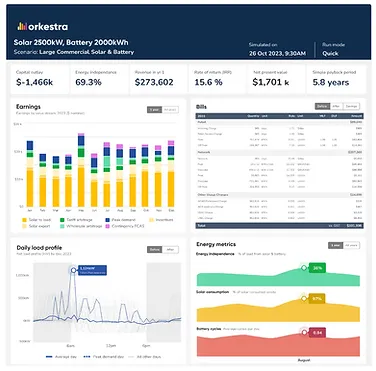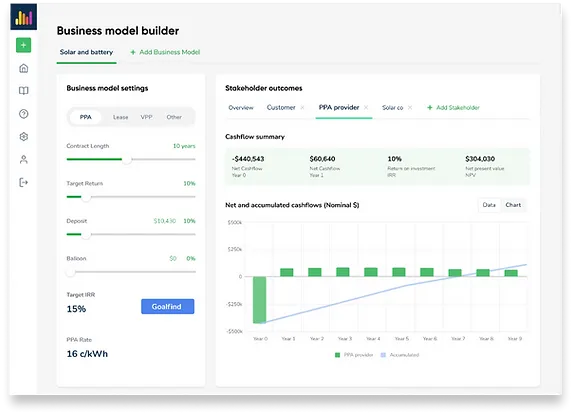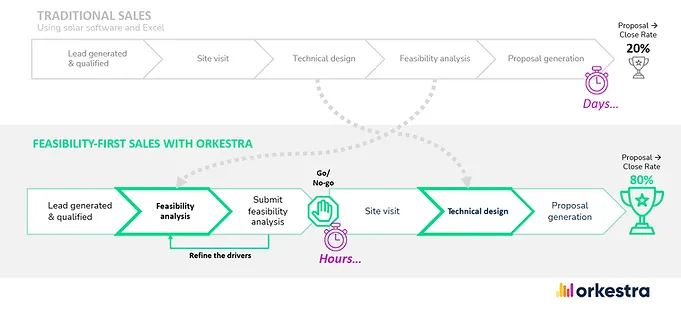Blog /
Industry Insights
How to Unlock and Rapidly Scale the C&I Solar and Battery Market
November 2, 2023
Presenting at this year's All Energy conference, Orkestra Co-CEO and Co-Founder James Allston shares key insights around the critical need for solar and energy companies to unlock the C&I market.
Watch the full presentation below, with links and further reading provided in the accompanying blog.
The urgency of decarbonisation and the role of the solar commercial and industrial (C&I) sector
According to Bloomberg New Energy reports from 2021 and 2022, to get on track for net zero (globally) we would need to deploy:
- 5x more wind
- 3x more solar
- 26x more batteries
...and do this every year until 2030. That's a massive growth and according to Bloomberg, this is the only way to do it. Specifically looking at Australia's solar industry, that would look like doubling the rate of our solar deployment from where we are today. How can we realistically achieve this?
In Australia, most solar deployment has been in residential and utility scale deployment, and as we can see in the chart below, we have a hugely underperforming commercial and industrial sector. As of 2022, compared to nearly 3.3 million residential systems, the C&I sector in Australia has installed just 1,600 systems > 100kW and 50,000 25-100kW systems. This is a very small number of systems deployed, making the C&I market one with significant potential to assist us in reaching our targets, and as an important growth sector for solar installation and energy businesses.

According to modelling from Rystad Energy the residential solar industry is quickly running out of market, but the C&I market has the potential to accelerate, as seen in the graphs below. Alongside this is the potential of the battery market, which we also know will be an important growth market for the solar industry.

So as we can see, the C&I sector presents a massive opportunity, but it will require adjustments in the way the solar sector approach these projects and pitch to commercial customers.
What is it going to take to unlock the C&I solar and battery market?
In his presentation James outlines three key areas we should address in our approach to C&I solar energy projects:
- Taking a value based sales approach; move away from selling based on cost, to selling based on value
- Overcoming cost and complexity barriers
- Improving your sales team's efficiency

1. Sell based on Value
When moving to selling solar to C&I customers, the value of the system is going to be a lot more important than the cost or aesthetic; you will need to demonstrate value in a way that your customer understands.
This is an area where technology like Orkestra can play a critical role for the industry. Orkestra enables users to conduct in-depth feasibility analysis at scale, comparing hundreds of solar, battery and tariff combinations in minutes to generate different solutions for your client.

Once you've narrowed down the best potential solutions, the analysis can be pushed through to create visual, interactive reports to present to your client, and export out as a sales proposal. As seen in the screenshot below, a typical report in Orkestra is very visual, clearly presenting value in a way the customer can quickly and easily understand, showing:
- Revenue, IRR, NPV and simple payback periods
- Bill comparison to show before, after and savings
- Clearly defined earnings from various revenue streams associated with the system
Get your 3 week free trial
Get started exploring energy project feasibility analysis and reporting. Sign up now - no credit card required.
Sign up today2. Overcome cost and complexity barriers
There are several barriers that exist with the C&I space that don't necessarily exist in residential, such as seeking out capital to fund your ideal solar and battery system. This may seem like a cost barrier, but is actually more easily overcome in the C&I space, and you can use Orkestra to help you develop a business case.
Through Orkestra's new 'Business Model Builder' (BMB) users can now develop multi-stakeholder business models that transfer costs, risks and share value, as a start. This is an incredibly powerful way to easily and quickly develop business assets directly in the platform, potentially replacing weeks of modelling in excel, including:
- Power Purchase Agreements (PPAs)
- Equipment Leases
- Virtual Power Plants (VPP)
- Revenue Shares
- Embedded networks
- EV charging
- Retail-integrated PPAs
The BMB enables both templated and more complex business modelling innovation, directly within Orkestra using your solution analysis. You can trial the BMB as part of your free 3 week trial of Orkestra.

3. Improve Sales Efficiency
In order to move into selling solar to the C&I sector it is going to be critical to improve the efficiency of solar sales teams and their ability to sell based on value and feasibility - and we can now do this through technology, specifically Orkestra. The Orkestra platform makes the feasibility analysis of solar energy projects faster and more accessible for sales and junior team members to perform.
With feasibility analysis now easier and faster to perform, a solar sales team can flip their approach and move this to a much earlier point in the process.

For the C&I segment, quickly demonstrating the value of the system up front will be critical, and enables sales teams to quickly establish the likelihood of the sale before deploying engineering resources to drill down into more complex design and analysis.
"If you shift into a feasibility first mode it means that you can use your sales people and your juniors to do this feasibility work, and you're not deploying your really expensive engineers until very late in the project. It leads to a much more efficient sales engine within a business." - James Allston, Orkestra
You can explore 'Feasibility First Value Selling' further here.
We have the tools to rapidly scale the C&I solar and battery market
Achieving net zero demands rapid scaling of solar and batteries, and the good news is we DO have the technology and the tools to do it.
Unlocking sales teams to improve productivity and efficiency will be key to unlocking the C&I sector, and in doing so unlocking a further $18Billion for the Australian solar and battery market.
Switching to a feasibility first sales strategy will be a powerful growth and profit enabler for solar companies, and utilising Orkestra to improve sales processes is going to help us supercharge the industry to rapidly deploy new C&I solar energy projects. Ready to get started?
Get your 3 week free trial
Get started exploring energy project feasibility analysis and reporting. Sign up now - no credit card required.
Find out more about Orkestra and our Co-Founders James Allston, Michael Jurasovic and Chris Cooper here.


